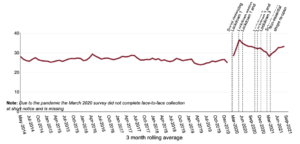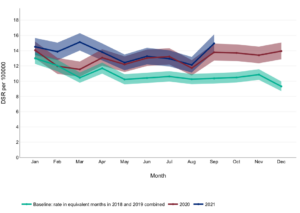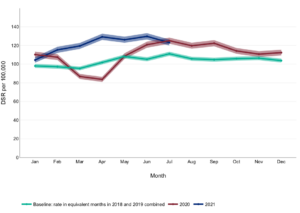
2021 was another year dominated by the COVID-19 pandemic. In December 2020 we published a blog by Colin Angus on what 2020 meant for alcohol consumption. At that time the alpha variant – then known as the ‘Kent variant’ – was causing the second wave of infections, and the vaccination programme had not yet started. After what feels like an incredibly long year, the short-term outlook now is very different to 12 months ago.
In the world of alcohol policy, all the main stories of 2021 can be found in IAS’ Year in Review edition of Alcohol Alert. This post is a recap of trends in alcohol consumption and harm in 2021.
So what happened?
In terms of alcohol consumption, in England, the rise in the proportion of people who are drinking at increasing or higher risk levels has been sustained through 2021:

Prevalence of increasing and higher risk drinking (AUDIT-C score 5+) in England. Source: Alcohol Toolkit Study, UCL, from OHID’s Wider Impacts of COVID-19 tool
Tax data also show the amount of alcohol cleared for sale was higher than before the pandemic. As illustrated by Colin Angus, in 2020 there was a 1.8% rise above previous levels, which rose to 4.9% in 2021 (year to September):
This increase is not spread evenly across society. Public Health England’s (PHE) July 2021 report on alcohol consumption and harm during COVID-19 summarised existing surveys and analysed alcohol purchasing data. One finding from this report was that the heaviest drinkers before the pandemic increased their alcohol purchasing the most.
In 2020 it was too early for many impacts on alcohol harm to be seen. In February 2021, provisional alcohol-specific deaths data for the first nine months of 2020 were released for England and Wales by the Office for National Statistics (ONS), showing a 16.4% increase in alcohol-specific deaths compared with 2019. In May 2021 when data were released for the whole of 2020, this turned out to be a 19.6% increase. More recent data available through the Office for Health Improvement and Disparities’ (formerly PHE) Wider Impacts of COVID-19 monitoring tool show this increase has persisted through 2021:

Monthly trend in mortality for all alcohol-specific conditions in England – all persons. Source: Mortality data from Office for National Statistics from OHID’s Wider Impacts of COVID-19 tool
Hospital data show a mixed picture regarding unplanned admissions to hospital for alcohol specific causes, explained in PHE’s report. There has been a significant increase in unplanned admissions for alcoholic liver disease since June 2020. Again this trend has persisted through 2021:

Monthly trend in emergency hospital admissions for alcoholic liver disease in England – all persons. Source: Hospital Episode Statistics from OHID’s Wider Impacts of COVID-19 tool
Finally, alcohol treatment. The National Drug Treatment Monitoring System found little change in the numbers entering substance use treatment services (alcohol and other drugs) in England over the first year of the pandemic. However there is evidence outcomes worsened: there was a 27% relative increase in deaths in substance use treatment between 2020 and 2021. The increase was the largest among the subgroup of ‘alcohol only’ clients, with a 44% increase in deaths during treatment, from 741 deaths in 2019-20 (1.6%) to 1,064 deaths in 2020-21 (2.3%).
What does 2022 have in store?
This year has already seen alcohol being subject of much attention, with the drinking cultures in Whitehall and 10 Downing Street in question, and warnings from the Royal College of Psychiatrists Addictions faculty on the numbers of increasing and higher risk drinkers. We are fortunate to have regular releases of statistics from organisations like ONS, PHE/OHID, HMRC and through the NDTMS. While there are some good news stories – for example we welcome the introduction of minimum unit pricing in Ireland – there is no evidence that consumption trends are returning to pre-pandemic levels, and other health consequences of these trends are yet to be realised. Ongoing research (some of which IAS is involved in) is modelling the medium-to-longer term impacts health, healthcare and health inequalities, and will be released later this year.
Written by Dr Sadie Boniface, Head of Research, Institute of Alcohol Studies
All IAS Blogposts are published with the permission of the author. The views expressed are solely the author’s own and do not necessarily represent the views of the Institute of Alcohol Studies.
